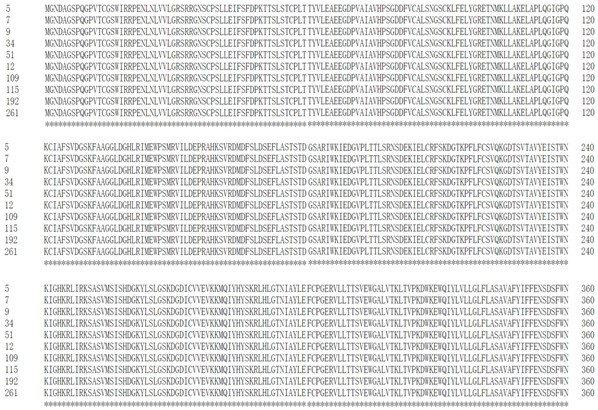SEC12-like protein gene CPU1 and application thereof in improving soybean phosphorus efficiency
A sec12-like, CPU1-H2 technology, applied in application, genetic engineering, plant genetic improvement, etc., can solve the problem of not being cloned into soybean phosphorus efficiency main gene
- Summary
- Abstract
- Description
- Claims
- Application Information
AI Technical Summary
Problems solved by technology
Method used
Image
Examples
Embodiment 1
[0027] Example 1, Genetic Mapping and Candidate Gene Identification of Phosphorus Uptake Efficiency
[0028] The present invention utilizes a set of core populations of soybean phosphorus efficiency germplasm resources (including 274 soybean materials) collected in the early stage to carry out field experiments in the experimental field of Boluo, Guangdong (East longitude 113°50′, North latitude 23°07′). Block design (1.5 m per plot 2 ), 4 blocks were set up, and the phenotype identification was carried out for the indicators related to phosphorus efficiency.
[0029] Determination of phosphorus content: phosphorus content (mg / plant) = phosphorus concentration (mg / g) × plant dry weight (g / plant), where phosphorus concentration is measured by colorimetry (Murphy and Riley, 1963).
[0030]Determination of total root length: In order to obtain a complete plant root system, use tools such as shovel to dig down in a square area of 40 cm × 40 cm (with the plant as the center), re...
Embodiment 2
[0037] Embodiment 2, CPU1 Cloning and functional verification of
[0038] according to CPU1 The cDNA sequence of the gene (as shown in SEQ ID NO.2) designed specific primers F1 / R1, using the cDNA sample of the wild-type soybean variety YC04-5 as a template to amplify a 147 bp fragment; using Swa Ⅰ+ Asc Ⅰ Digest the above 147bp fragment to obtain the forward fragment, and then clone the forward fragment into the pFGC5941 vector Swa I and Asc between Ⅰ; use SM a I+ Bam H I digested the above 147 bp fragment to obtain the reverse fragment, and then cloned the reverse fragment into the pFGC5941 vector that already contained the forward fragment SM a I and Bam The recombinant vector was obtained between HI, and the recombinant vector was transformed into Agrobacterium EHA105 competent cells, and the bacteria were shaken for subsequent use. Agrobacterium tumefaciens-mediated cotyledon node transformation method (Wang et al . 2009) to obtain CPU1 whole plant interv...
Embodiment 3
[0049] Embodiment 3, CPU1 Variations in amino acid sequence and expression
[0050] identified by genome-wide association analysis CPU1 ,illustrate CPU1 There is sequence variation in itself, which leads to phenotypic variation in the phosphorus uptake efficiency of soybean populations. Therefore, finding this functional variation site will provide valuable information for later gene editing breeding and precision molecular marker-assisted selection breeding.
[0051] Based on the resequencing results and genome-wide association analysis results in Example 1, the inventors found that there are mainly two CPU1 alleles of CPU1 - H1 (The nucleotide sequence is shown in SEQ ID NO.5) and CPU1- H2 (The nucleotide sequence is shown in SEQ ID NO.1), and the variation site significantly associated with phosphorus uptake efficiency exists in the promoter region and 5'UTR, and no associated signal is found in the coding region, implying the variation of phosphorus uptake efficienc...
PUM
 Login to View More
Login to View More Abstract
Description
Claims
Application Information
 Login to View More
Login to View More - R&D
- Intellectual Property
- Life Sciences
- Materials
- Tech Scout
- Unparalleled Data Quality
- Higher Quality Content
- 60% Fewer Hallucinations
Browse by: Latest US Patents, China's latest patents, Technical Efficacy Thesaurus, Application Domain, Technology Topic, Popular Technical Reports.
© 2025 PatSnap. All rights reserved.Legal|Privacy policy|Modern Slavery Act Transparency Statement|Sitemap|About US| Contact US: help@patsnap.com



